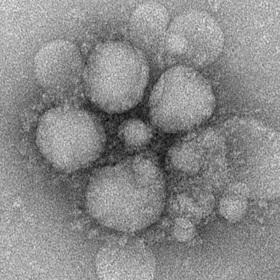Using AI to control energy for indoor agriculture
30 September 2024
Published online 25 September 2013

Researchers suggest the Middle East Respiratory Syndrome Coronavirus (MERS-CoV), which has raised concerns of a new influenza epidemic, may be infecting humans via multiple transmission chains.
In a new study published in The Lancet1, researchers from the UK and Saudi Arabia analysed the genomes of MERS-CoV samples taken from 21 patients, drawing a more accurate picture of the virus's evolution and geographical spread.
According to the Centers for Disease Control and Prevention in the US, as of last week, MERS-CoV had infected 130 people, 58 fatally. A total of 108 of these cases were reported in Saudi Arabia alone, the remainder in Jordan, Qatar, the UAE, Tunisia, France, Italy and the UK.
This latest study did not seek to find the virus's origin, but provides evidence that its transmission patterns are more complex than previously thought, probably involving multiple animal to human infections.
The researchers connected the studied patients' geographical locations — all in Saudi Arabia when infected — with when they were infected, along with the level of genetic difference seen between the genomes.
They found significant differences in the genomes of the viruses analysed. These differences were too marked to be the result of replication errors if the virus had only passed from human to human. Instead, it appears that different lineages of the virus originated from animal to human transmission several times.
The results also suggest that the virus is centred on Riyadh, with only isolated excursions to other areas.
Confirmation that can be derived from the data is limited by a relatively small number of genomes analysed in the study. Four of the 21 genomes were sequenced only at 30-50%.
"We are amplifying and sequencing the virus directly from patients," explains Mathew Cotton, from the Sanger Institute and the study's lead author. "If the patient sample had low quantities of the virus, we were not able to obtain the complete genome." The researchers are continuing to work with the Saudi Health Ministry to sequence the virus.
Ian Jones, a virologist at the University of Reading, UK, says that "the study broadly supports the general view that this is an occasional zoonotic infection—either directly or indirectly, such as by contaminated food—from an unknown source, so the multiple events of vector-to-man transmission are not unexpected."
However, while Jones agrees that multiple animal to human transmissions match the observed patterns of infection, he notes that scientists are no closer to knowing the virus's source.
Bats are one carrier under consideration, though scientists doubt they are directly infecting people. Camels are also known to be infected by the virus, or a close relative of it, and many of the people infected were reported to have had direct or indirect contact with them.
Currently, while millions are expected to congregate in Mecca next month for the annual Hajj, the risk of a pandemic has been deemed minimal.
"The possible low level human-to-human spread suggested is very unlikely," says Jones. "But we really need more data to rule it out completely."
doi:10.1038/nmiddleeast.2013.164
Stay connected: